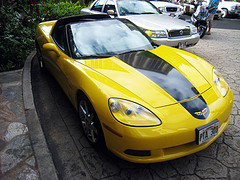
flickr.com/savannahgrandfather
People lease cars for various reasons. Some drivers are capable of writing off their transportation costs at tax time. There are those who lease to provide themselves with a regular supply of new cars. Others still simply favour leasing to the hassles of car ownership.
Whatever your rationale for leasing a car, you need to know how to spot a good deal, and save money on your lease.
Incentives
The automotive industry is extremely competitive, and there are always factory subsidized lease deals on hand. Car manufacturers recognize that if you lease their particular brand of car, you’re more likely to become a repeat customer. On the other hand, people who purchase cars are less likely to buy another new car for a number of years. With these information in mind, manufacturers are willing to adjust residual values and provide lower financing charges through their leasing companies. Some automotive manufacturers are also giving leasing financial assistance. These incentives are subsidies proposed to encourage consumers to choose slow selling models, and save even more money.
Competitive Bidding
As the consumer, you ultimately hold the decision on how and where to spend your money. Set up your own competitive bidding environment to obtain the lowest price. If you already know the model and make of the car you’re looking for, try estimating your own lease payments before shopping. Use a lease calculator or an online comparison tools to determine the lease payment based on the advertised purchase price. With these figures in hand, you will be able to solicit quotes from a variety of leasing companies, and have greater bargaining leverage. Having the upper hand in the negotiations will help you to avoid unnecessarily exaggerated payments.
Learn the Terms and Fees
Understand and research all of the leasing details, including fees, before signing the contract. Despite the dealer’s promise of “no money down”, there will be charges that are payable at the start of your lease. Title, license, and registration fees are all due before you drive away with your leased vehicle. Other fees payable up front are acquisition and freight fees and state, local, or provincial taxes. Fees may also be paid at the end of your lease agreement. There may be a disposition fee payable, as well as extra charges for excess mileage and wear. Learn the mileage limit, and determine whether it is enough to cover your usage. Most lease agreements allow 15,000 miles yearly, and charge 10 to 20 cents for every single mile that you use over and above the agreed limit. Those miles can simply add up to thousands of dollars payable by you at the end of your lease. Smart consumers will negotiate a higher mileage, or pad excess miles at the start of the lease to avoid paying high tax rates for extra miles. If you are a commuter that puts a lot of miles on your vehicle, the costs can rapidly add up. Remember, you’re in the driver’s seat, so negotiate a higher mileage allowance. It’s important to note that some of these charges, like the disposition and acquisition fees are negotiable, so don’t be afraid to dicker for a better lease price.
GAP Coverage
Over and above your regular car insurance, be sure that your lease agreement covers GAP coverage. This extra insurance plan will cover you if your vehicle is damaged in a collision or stolen. Without GAP insurance, you will be liable for paying thousands of dollars in leasing obligations. Some lease plans include GAP insurance automatically, so check your contract to ensure you’re not paying twice for the same coverage.
Leasing a car is a huge financial obligation, and it’s much harder to get out of a lease than it is to get in to one. Make sure that you understand all of the obligations and terms, and read all of the fine prints, before signing the dotted line.
Tagged with: leasing • used cars
Filed under: Buy A Car